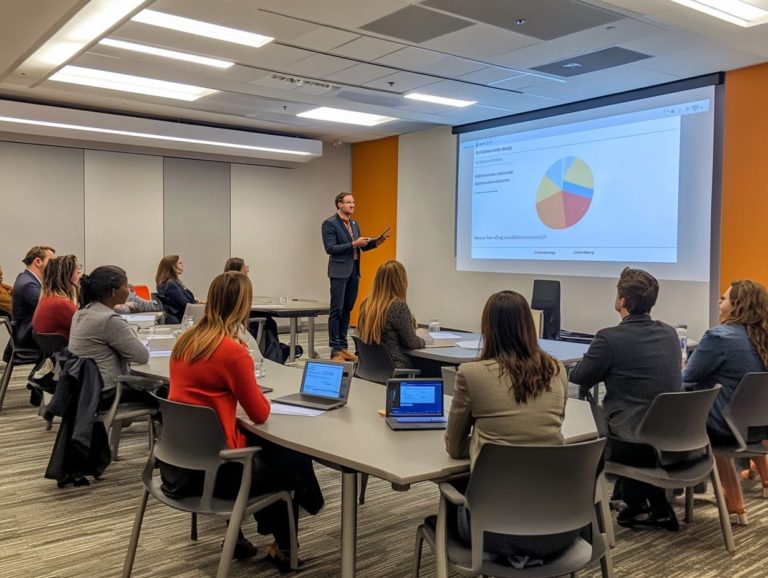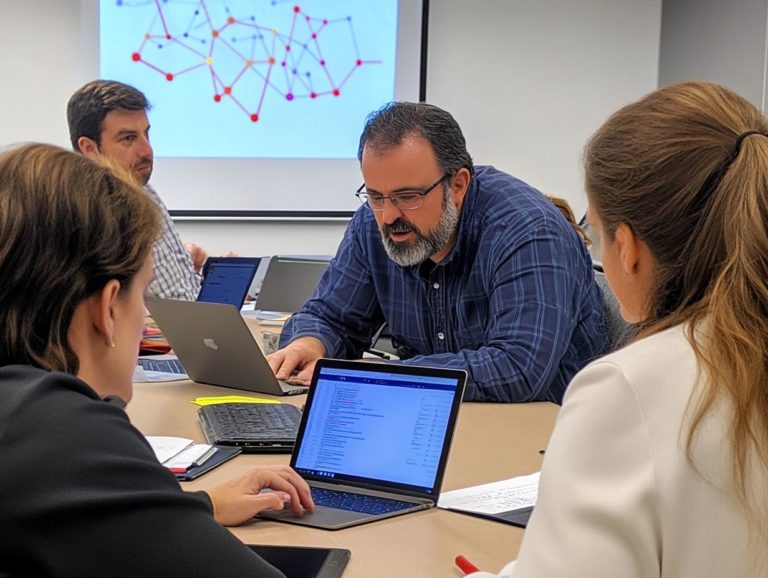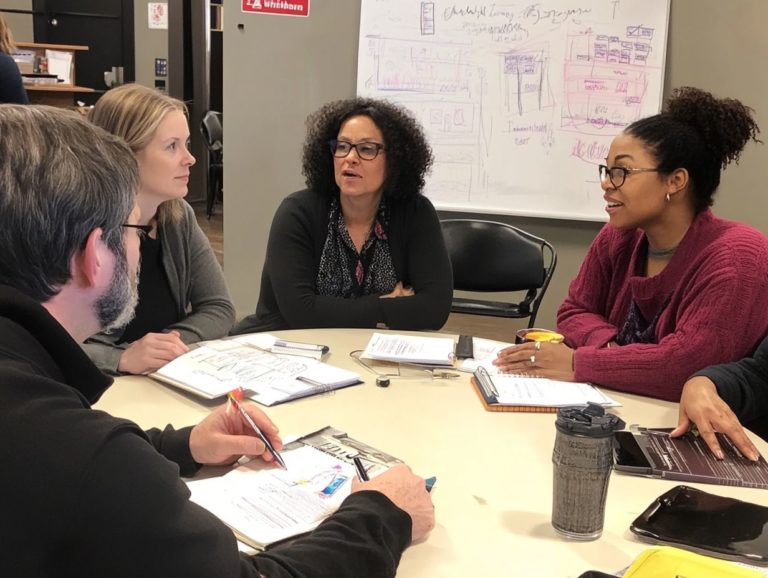How to Facilitate Group Training Sessions?
Group training sessions present a dynamic and collaborative opportunity to elevate your learning and development, providing significant benefits for both you and the trainers involved.
In this article, you ll explore the essence of group training, along with its many benefits and the key parts that lead to a successful session. Get ready to uncover effective facilitation techniques, discover engaging strategies to captivate participants, and learn how to tackle challenges that may arise during the process.
Feedback is important for continuous improvement. Immerse yourself in this exploration to enhance your group training experience!
Contents
- Key Takeaways:
- What Are Group Training Sessions?
- Benefits of Group Training Sessions
- Essential Elements of a Successful Group Training Session
- Facilitating Group Training Sessions
- Tips for a Smooth and Productive Session
- Evaluating and Improving Group Training Sessions
- Frequently Asked Questions
- What is the role of a facilitator in group training sessions?
- How do I prepare for a group training session as a facilitator?
- What are some effective strategies for engaging participants in group training sessions?
- How do I handle conflicts or disagreements among participants during a group training session?
- As a facilitator, how do I ensure that all participants are actively involved in the training session?
- What can I do to evaluate the success of a group training session as a facilitator?
Key Takeaways:

- Effective group training sessions require thorough planning and preparation, as well as engaging participants through effective communication and instruction.
- Group training sessions benefit both participants and trainers, providing a collaborative learning environment and valuable feedback for improvement.
- To ensure a smooth and productive session, it is important to encourage participation and address any challenges that may arise, while also continually evaluating and improving through feedback and reflection.
What Are Group Training Sessions?
Understanding group training sessions is vital for anyone eager to harness the power of effective facilitation in the workplace. Learning how to facilitate virtual learning sessions means guiding discussions and managing group dynamics. These sessions provide a structured environment where you can enhance your teamwork skills and acquire practical abilities.
As a facilitator, your role becomes critical in guiding discussions, managing group dynamics, and ensuring that every voice is heard. This approach ultimately fosters successful outcomes.
By participating in group training sessions, you empower yourself with a facilitation mindset, equipping yourself with essential competencies that will drive progress in your professional journey.
Definition and Purpose
Group training sessions are structured gatherings designed for you to collaborate with others, enhancing your skills and knowledge through effective facilitation.
These sessions aim to create a supportive environment where you can actively engage with your peers, discuss real-life applications, and tackle challenges together. The primary objective is to equip you with new competencies that can be utilized in both your professional and personal life, while also fostering team cohesion.
By employing methodologies such as interactive workshops and experiential learning, facilitators draw on resources from established entities like the Australian Groupwork Centre to craft impactful curricula. Effective communication skills are essential in these sessions, ensuring that everyone feels heard and valued, paving the way for meaningful collaboration and growth.
Benefits of Group Training Sessions
Engaging in group training sessions presents a wealth of advantages for both participants and trainers. These collaborative environments not only cultivate essential teamwork skills but also significantly enhance workplace dynamics, which are vital for driving effective progress.
For Participants
Group training sessions offer you invaluable opportunities to cultivate essential life competencies, such as conflict resolution and effective communication.
In these interactive environments, you foster collaboration, engaging deeply with your peers, sharing diverse perspectives, and practicing real-world scenarios. By concentrating on role-playing exercises, you sharpen your interpersonal skills and learn to navigate challenging conversations with newfound confidence.
The shared experiences during these sessions create a sense of community, encouraging you to forge lasting connections that enhance your learning journey. Immersing yourself in such dynamic settings helps you develop greater emotional intelligence, empowering you to handle conflicts amicably and articulate your thoughts with clarity skills that are essential not only in your professional life but also in your personal relationships.
For Trainers
For trainers, group training sessions present a golden opportunity to refine facilitation skills while cultivating an inclusive learning environment.
These sessions empower you to experiment with various techniques aimed at effectively engaging participants, resulting in more impactful discussions and interactions. By mastering effective facilitation methods, you can foster a dynamic atmosphere that promotes collaboration and knowledge sharing among attendees.
As you hone your communication skills, you enhance your ability to convey ideas with clarity and learn to read group dynamics more adeptly. Organizations like HRDQ provide valuable resources and training programs specifically designed to elevate these essential competencies, ensuring that you are well-prepared to lead successful sessions that resonate with diverse audiences.
Essential Elements of a Successful Group Training Session
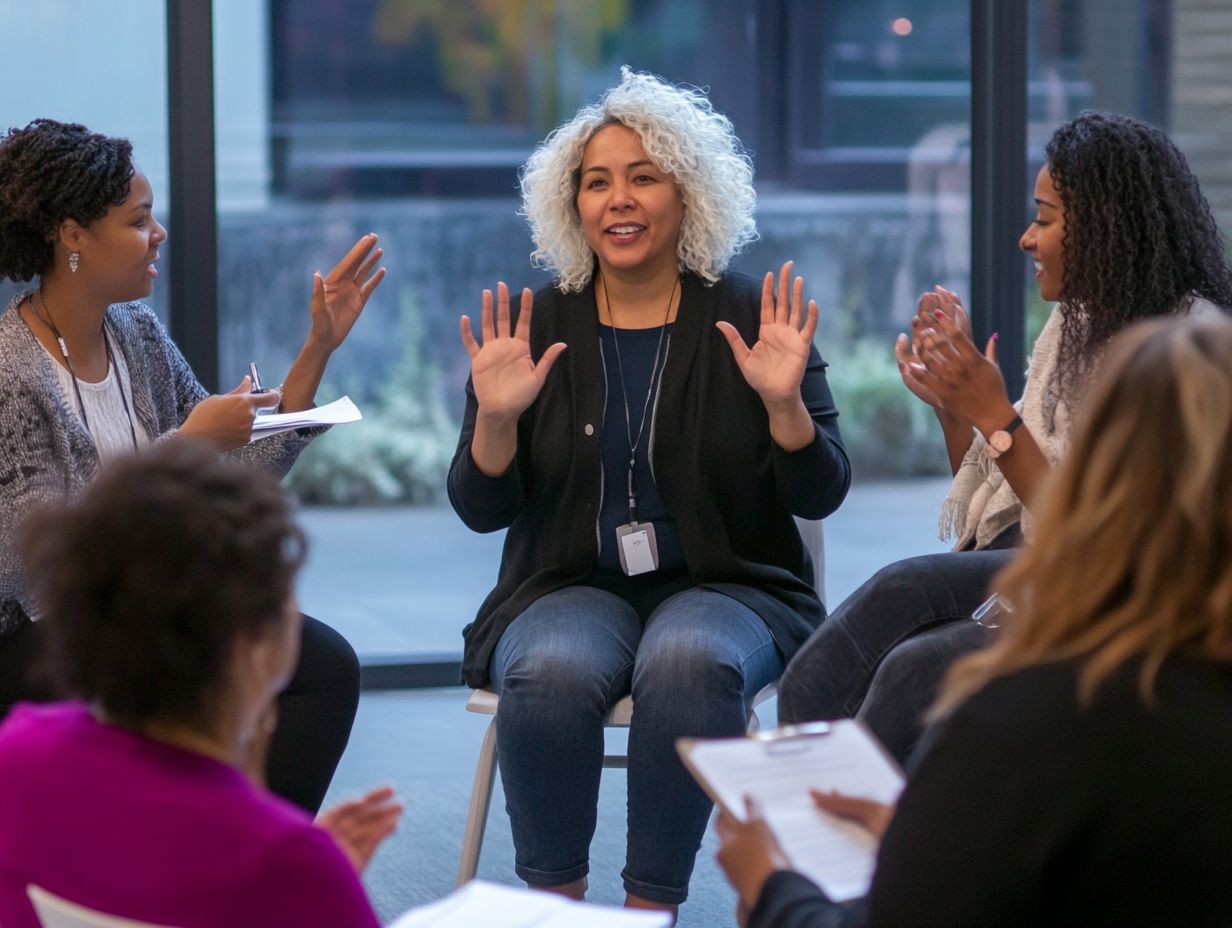
Successful group training sessions rely on careful planning, engaging techniques, and a good grasp of group dynamics.
By focusing on these aspects, you can ensure that the session yields productive outcomes and resonates with all participants.
Planning and Preparation
Planning and preparation are essential when organizing effective group training sessions. This involves crafting detailed meeting agendas and designing engaging workshops.
These processes form the foundation for success, ensuring that every aspect of the session is carefully considered. A solid planning process clarifies your goals and sets you up for success.
By developing comprehensive meeting agendas, you can prioritize key topics. This allows for in-depth exploration and interaction.
This intentional approach fosters engagement and sets the stage for meaningful outcomes, ensuring that the training aligns with organizational goals while effectively enhancing participants’ skills.
How to Engage Participants Effectively
Engaging participants effectively is a hallmark of successful group training sessions, and it all starts with your strong communication skills and an array of tools for facilitation at your disposal.
Create an environment where everyone feels valued and heard; it s crucial! One effective strategy to consider is incorporating interactive activities, such as breakout groups or role-playing scenarios. These not only serve to break the ice but also encourage deeper involvement among participants.
Utilizing digital platforms like Mentimeter or Kahoot can elevate your sessions by facilitating real-time feedback and stimulating engagement through quizzes and polls. Employing active listening techniques helps build rapport and trust, making participants more inclined to share their thoughts openly.
By embracing these methods, you can enhance interactivity and create a vibrant atmosphere that fosters learning and collaboration.
Facilitating Group Training Sessions
Facilitating group training sessions demands a sophisticated blend of effective communication skills and adept meeting management. You must ensure that team dynamics are positively influenced, paving the way for productive outcomes that truly resonate. To enhance this process, consider exploring how to foster team collaboration in training.
Effective Communication and Instruction
Effective communication and instruction are vital components of successful group training sessions. They enable you to bridge communication barriers and foster understanding among participants.
These elements help you convey information clearly and cultivate an environment where everyone feels valued and engaged.
Mastering active listening techniques, utilizing body language with intention, and nurturing an atmosphere of openness and trust can significantly enhance your interactions.
Being mindful of diverse communication styles and cultural backgrounds allows you to anticipate potential misunderstandings before they arise. By employing strategies such as summarizing key points and encouraging questions, you can elevate group dynamics, ensuring that every participant contributes meaningfully and reaps the full benefits of the session.
Start applying these strategies today and see the difference in your training sessions!
Managing Group Dynamics
Managing group dynamics is crucial for you as a facilitator. Create an environment that encourages open communication. This allows individuals to express concerns and opinions freely, without fear of backlash. By employing active listening techniques, you can uncover underlying issues that may spark conflicts, enabling you to step in with timely interventions.
Using conflict resolution strategies like mediation and collaborative problem-solving can turn potential discord into valuable opportunities for growth.
Enhance teamwork now by encouraging engaging group activities that build trust and cooperation, highlighting shared goals and interdependence. Creating a safe space for dialogue not only empowers participants but also strengthens the overall cohesion and effectiveness of the group.
Tips for a Smooth and Productive Session
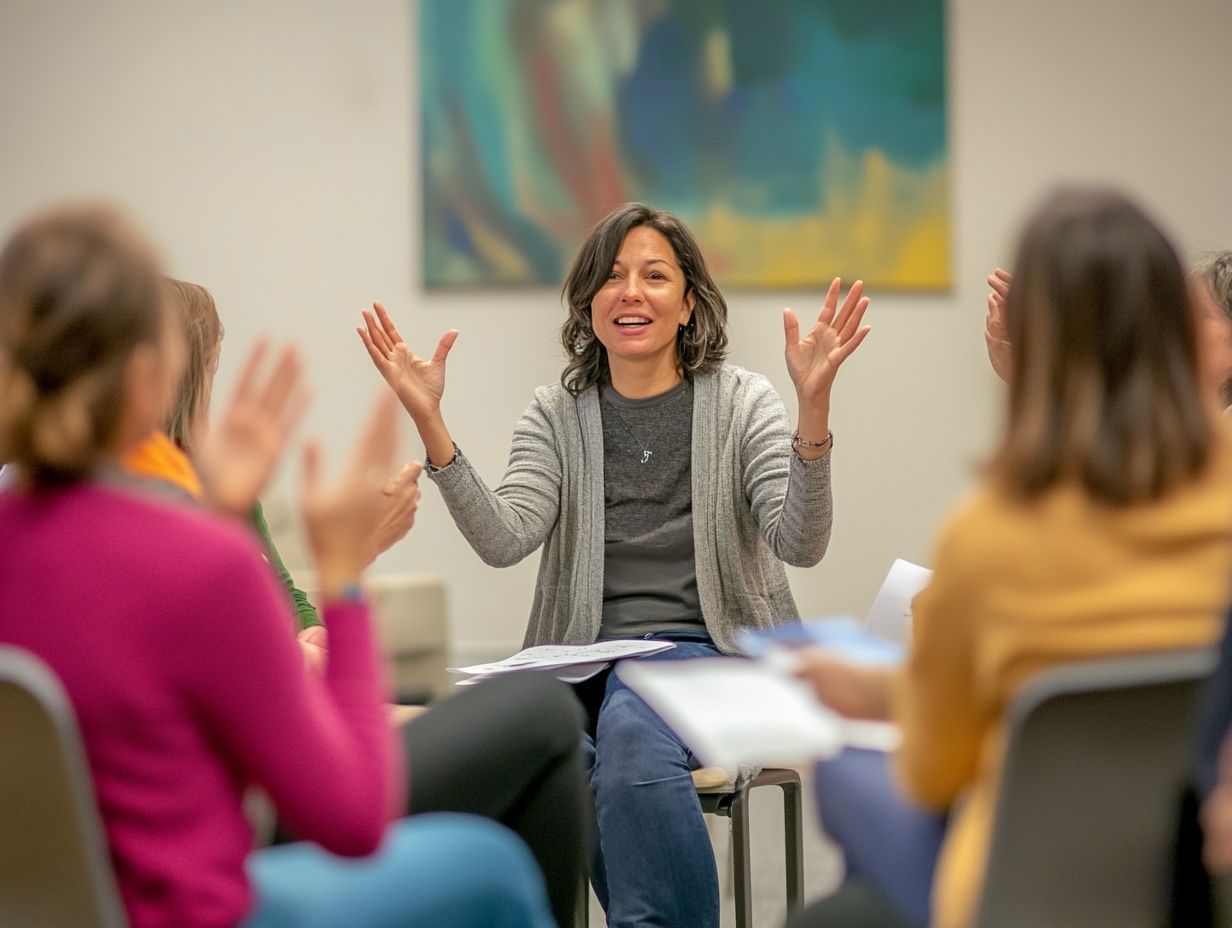
To ensure a smooth and productive session, focus on encouraging participation by employing innovative engagement techniques alongside effective facilitation methods. This approach also enhances interaction and fosters a collaborative atmosphere, allowing everyone to contribute meaningfully.
Encouraging Participation
Encouraging participation is essential for crafting an inclusive environment where you and your peers feel genuinely valued and engaged. This fosters a collaborative mindset among everyone involved.
You can achieve this through various methods, such as practicing active listening, offering positive reinforcement, and ensuring equal opportunities for contributions. Incorporating diverse group activities allows individuals from various backgrounds to share their unique perspectives, enriching the overall experience for all.
Using tools like anonymous surveys or suggestion boxes can also empower those quieter voices, ensuring that everyone has a chance to express their thoughts. By acknowledging contributions and collectively celebrating successes, you cultivate a sense of belonging that elevates morale and enhances overall engagement within the group.
Addressing Challenges
Addressing challenges during group training sessions often means navigating communication barriers and streamlining processes to ensure effective progress. These obstacles include misunderstandings and unclear objectives, which can hinder the overall effectiveness of the training.
To tackle these issues, it s essential for you as a trainer to cultivate an environment that encourages open dialogue and active participation. Consider implementing strategies such as:
- Setting clear agendas for meetings,
- Employing collaborative tools for feedback, and
- Establishing ground rules.
These approaches can significantly enhance communication. Incorporating icebreakers and team-building activities can further help build rapport, ultimately leading to a more cohesive and engaged group dynamic.
Evaluating and Improving Group Training Sessions
Evaluating and enhancing group training sessions is essential for achieving sustained success. It involves a careful reliance on feedback and reflection, allowing you to create actionable plans that foster continual improvement.
Feedback and Reflection
Feedback and reflection are integral to your evaluation process, offering valuable insights into participant engagement and the effectiveness of your facilitation.
To truly grasp the dynamics of any group training session, it’s essential to gather feedback through various methods. Techniques like anonymous surveys, one-on-one interviews, and interactive feedback tools can unveil participants perceptions about both the training content and the overall atmosphere.
Reflection empowers you to critically assess the session’s outcomes, taking into account not only the overall engagement but also the individual contributions and learning experiences.
This two-pronged approach enables a more nuanced evaluation, ensuring that future training sessions are finely tuned to meet participants’ needs while simultaneously enhancing your skills as a facilitator.
Continual Improvement Strategies
Continual improvement strategies are essential for elevating your group training sessions. They allow you to craft effective action plans that adapt seamlessly to the ever-changing dynamics of the workplace.
By actively seeking feedback and analyzing participant engagement, you can pinpoint areas ripe for growth. Using performance data and integrating innovative technology, like virtual reality and learning through games, not only enriches these sessions but also keeps participants engaged and interested.
Make time for reflection and discussion to supercharge your team’s learning! This fosters a culture of continuous learning and empowers your team to adjust and refine their methods.
Embracing these strategies leads to more impactful training outcomes. Ultimately, this significantly enhances both individual and team productivity.
Frequently Asked Questions
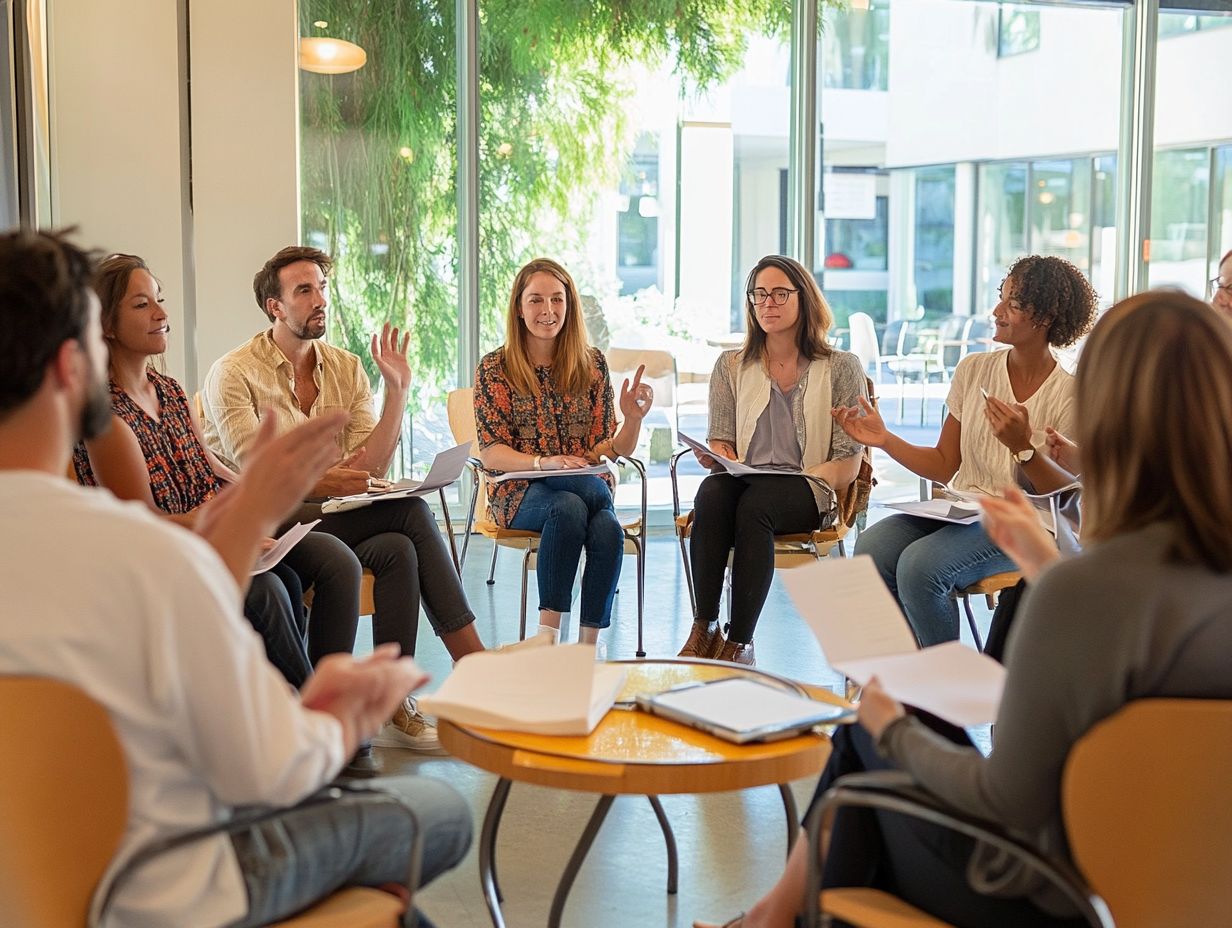
What is the role of a facilitator in group training sessions?
The facilitator’s role is to guide and support the group in achieving their learning objectives. They create a safe and engaging learning environment.
How do I prepare for a group training session as a facilitator?
Before the session, familiarize yourself with the content and objectives. Create a detailed agenda and gather any necessary materials or resources.
What are some effective strategies for engaging participants in group training sessions?
Some strategies include using interactive activities and encouraging open discussions. Incorporating real-life examples and case studies is also effective.
How do I handle conflicts or disagreements among participants during a group training session?
As a facilitator, it is important to remain neutral and encourage respectful communication. Use techniques like active listening and mediation to resolve conflicts.
As a facilitator, how do I ensure that all participants are actively involved in the training session?
Encourage equal participation by asking open-ended questions. Assign roles or tasks and provide opportunities for everyone to share their thoughts and ideas.
What can I do to evaluate the success of a group training session as a facilitator?
You can use various methods such as participant feedback forms and observation. Post-training assessments also help evaluate the session and make improvements for future sessions.
Ready to implement these strategies in your next training session? Start enhancing participant engagement today!


